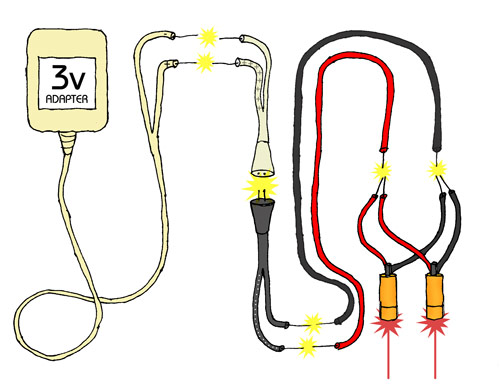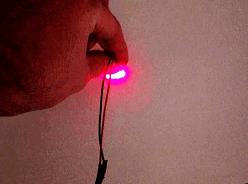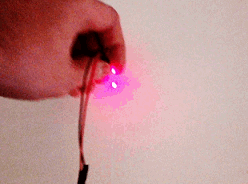Essay Part V - Do-It-Yourself Laser Therapy / LLLT Introduction
.jpg)

Seriously, EVERY KID my age wanted to be "Hank the Ranger"!
Look... it doesn't matter how you make your device look, it just has to have several principles in order for it to operate as effectively as it can! This is true for both a standard laser brush/comb and a high-powered laser device.
1) It has to be wired PARALLEL, not series! All this means is that you DON'T wire the diodes like a "daisy chain". You basically group ALL of the red wires together and connect them to the positive wire of the adapter, and group ALL of the black wires together and connect them to the negative side of the adapter.
This ensures that each diode gets the full amount of volts that the diode requires. A lot of early "do-it-yourself" pages showed designs that incorporated "series" wiring, which means that the red wires of one diode was connected to the black of the next on, etc. This results in the voltage getting SPLIT among each of the diodes. Those early do-it-yourself pages are WRONG to do it that way!!! lol...
For more complete details about HOW to wire, check out my page, "How ridiculously easy wiring is"... but lets go ahead and take a quick look at this picture, and you'll start to see that wiring these diodes is very simple:

See?? All reds to positive, all blacks to negative... it's that easy! Laser diodes (at least the ones we use) have circuitry built in them that makes this simple.
2) The diodes should be close together. This allows for a more solid block of coverage. True, this is an opinion... but it's a strong enough opinion that I put it second on this list. As far as doing this, you can easily just use electrical tape and tape together the diodes, but this should really only be done if you are using a small amount of diodes. The reason for this is because if you have a large amount of diodes taped together, it would be VERY HARD to swap them out if one of them burns out or malfunctions. You would end up having to tear up the whole shebang! So what do you do when you have a crapload of diodes??
You find some sort of mesh to put them in! With the AiXiZ diodes that many of us use, "gutter guard" from Home Depot works pretty well. I don't know if it'll work for others, but you find it usually in the very back corner of Home Depot on the lumber side, and it's very cheap (currently at $1.60 as I type this). Here is the link to it: Amerimax Home Products White Vinyl Snap In Gutter Guard.

Unfortunately, inserting those diodes causes a "bow" in the gutter guard, but fortunately your head is curved. However, with some designs it might cause a little bit of problems (easy to fix, though), but I'll save that discussion for another time.
Although it can work -and I've seen some examples that look pretty good- this probably means that just drilling holes into a bicycle helmet probably isn't the best way to do it -if you are going for as many diodes as you can, that is. Think about it... if you put as many holes as you'd need for all the diodes to cover your scalp, it would swiss cheese it so much that it would collapse! Only consider that type of design if you feel that you don't need to have as many diodes as possible, as close together as possible.
Also, I personally feel that using "diffused" diodes is better because it allows for a more solid coverage area, but these are my feelings only and any added benefit hasn't been proven. There is more info on this in my "A quick note on diodes and power" section (including some very illustrative pictures) but in a nutshell, diffusing a diode consists of buying diodes with "focusable" lenses, unscrewing and removing those lenses, and therefore causing them to spread out over a larger, rectangular area.


However, using diffused diodes results in a trade-off between drastically increased time/decreased power and better coverage. This is pointed out in the "Laser Power Calculations by Guy Incognito" section.
3) The diodes should be as close to a uniform height above the scalp as possible. The power of the lasers hitting your scalp is affected by the height away from the scalp, ESPECIALLY when you have diffused diodes (please check the "Laser Power Calculations by Guy Incognito" page for more details)! That's because the power lessens per square centimeter as the beam spreads out. The best way to do this? Rest it on brush bristles. Those are about 2cms, which is a great height for diffused lasers in that mesh we were talking about.
It needs to be a uniform height so we can properly calculate the power you are getting to help ensure you are getting in the 3-6 joule range. I, of course, came to this realization AFTER I made my helmet! My helmet has the diode cluster suspended over my scalp, and it's almost impossible to match up the curve of the cluster to the curve of your scalp. This can result in a big difference of power from one spot to another, and I cover this more in the section showcasing my helmet.
Anyway, just pick up from this that it's better to rest the cluster on bristles vs. suspend it if you are using diffused diodes!
4) You need to have the proper power supply/adapter. The adapter has to have the right amounts of volts and the enough amps to properly power the diodes. As far as the volts... look, I don't know everything about this -and I'll cover this more in the "A quick note on diodes and power" section- but you'll get diodes that say "3.2" volts or "4.5" volts, whatever, but you'll see adapters that have only a "3 volt" or a "5 volt" option. In my experience -and don't hold me to this if yours screw up- but YES, that's FINE!
My laser helmet has diodes that had "3.2 volts" written on the bag, and I'm using a 3 volt adapter. Also, it has been brought up in the forums that those diodes will work just fine at *any* adapter setting from 3 to 5 volts. I don't know how true that is, but the point I'm making is that don't let yourself get confused here! 3.2 volt diodes work just fine with a 3 volt adapter!
As far as the amps, it's simple subtraction. Your adapter has a certain amount of amps that it can take, and each diode draws a certain amount. I know that the diodes I use draw approximately 30 mA (milliamps) per diode (although it's probably actually slightly less, but it's a good number to use). I know that they draw 30mA a piece because I ASKED THE PLACE I BOUGHT IT FROM! lol... that's how you find that out!
Ok, That means that if your 3 volt or whatever adapter has 1 amp, you obviously have 1000mA. If one diode draws 30mA, then you can power 1000/30 = 33.3 diodes! Easy, huh!
So, if you have a LOT of diodes, it get's harder to find an adapter with high enough amps! ...So go to my "Power Supplies" page and we have some solutions for you.
Ok, well those are the major requirements that any design should have! As long as these requirements are reached... the world is your oyster! Time to sum up everything and make some final points.... let's go to "Summary: Lasers for Hair Loss 101"!



.jpg)
.jpg)
.jpg)
.jpg)
.jpg)
.jpg)
.jpg)
.jpg)
.jpg)
.jpg)
.jpg)
Comments (0)
Login | Register